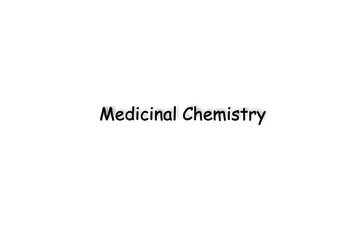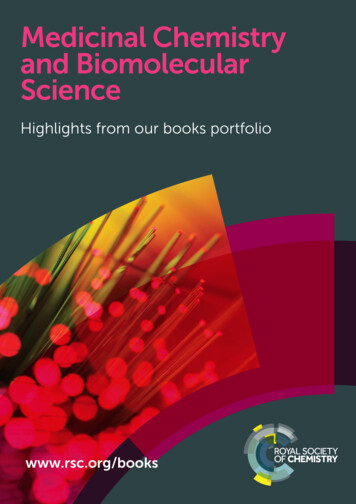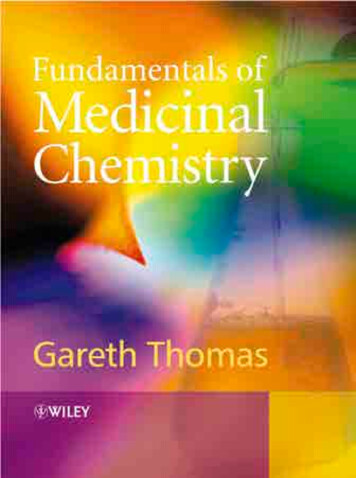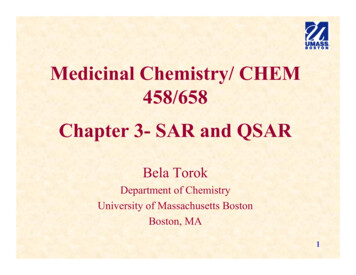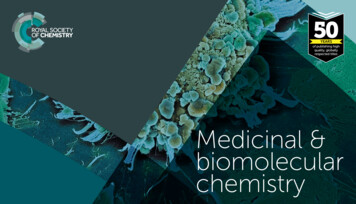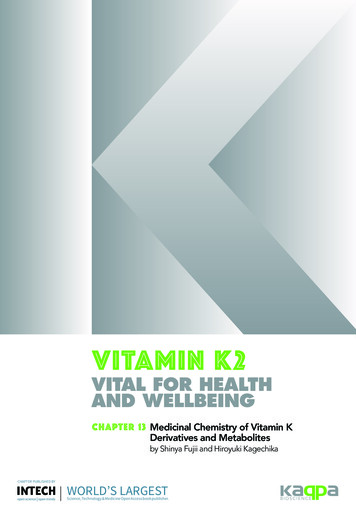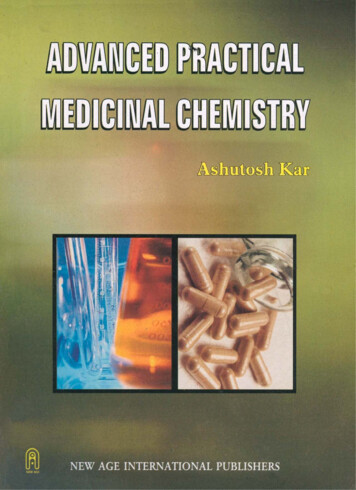
Transcription
This pageintentionally leftblank
Copyright 2004, New Age International (P) Ltd., PublishersPublished by New Age International (P) Ltd., PublishersAll rights reserved.No part of this ebook may be reproduced in any form, by photostat, microfilm,xerography, or any other means, or incorporated into any information retrievalsystem, electronic or mechanical, without the written permission of the publisher.All inquiries should be emailed to rights@newagepublishers.comISBN (13) : 978-81-224-2553-6PUBLISHING FOR ONE WORLDNEW AGE INTERNATIONAL (P) LIMITED, PUBLISHERS4835/24, Ansari Road, Daryaganj, New Delhi - 110002Visit us at www.newagepublishers.com
This pageintentionally leftblank
PREFACEThe ‘art and skill’ for the preparation of ‘newer drug molecules’ is a pivotal creative and anexceptionally great intellectual exercise that essentially serves as a fulcrum to plethora of specific areas of scientific research, ranging from the most applied to the most academic. Accordingly, the medicinal chemist, organic chemist, biologist, pharmacologist, biochemist,biotechnologist, phytochemist, genetic engineer, materials scientist, and polymer scientist, inan university or an industry, all must have genuinely encountered with the most challengingand intricate task of performing a reaction ultimately leading to an entirely new organic preparation exhibiting certain specific actions on the biological system to combat diseases in theailing human beings.Invariably, the wonderful ‘magic’ of modern organic synthesis, based on host of documented theories, hypothesis, organic name reactions (ONRs) amalgamated with logistic, scientific and assertive reaction mechanism(s), in fact, genuinely paved the way of complicated, notso-easy, cumbersome course of reactions much simpler and understandable.The advent of ever-more sophisticated and many supportive modern analytical techniques, such as : UV, IR, NMR, MS, ORD, CD, AAS, FES, GC, HPLC and the hyphenatedtechniques as well, have tremendously enhanced the confidence of medicinal chemists to such amagnitude as to maximize both the chances of success rate and probability factor.Besides, the use of organic and inorganic chemicals employed as reactants, catalysts,medium of reaction, purifying substances etc., are not only harmful but also hazardous in nature. Nevertheless, the various conditionalities of critical and specific reactions are sometimesarticulated and spelled out so meticulously that one has to follow them just like ‘gospel truth’,to accomplish the right synthesis, and hence, the right product.It is, however, pertinent to mention here that the UG and PG students, associated withthe myth and reality of ‘drug synthesis’ should make an honest attempt to carry out a particular synthesis of a drug substance with a most tried and tested methodical, scientific and rational approach, so that one may get reproducible results under a particular reaction in a seamless manner.The copious volumes of textbooks, scientific research journals, monographs, review articles on related topics like : organic chemistry of drug synthesis, chiral chemistry, drug design,principles of medicinal chemistry, organic medicinal and pharmaceutical chemistry, and medicinal chemistry provide ample evidence and scope to suggest that the comprehensive in-depthknowledge together with utmost specialized state-of-the-art know-how of the various techniquesis an absolute necessity and basic requirement to have a real understanding with regard to thepractical aspects of ‘Medicinal Chemistry’.In ‘Advanced Practical Medicinal Chemistry’, an attempt has been made to stressthe much needed requirement of both undergraduate and graduate students specializing in thefield of Pharmaceutical Chemistry to learn how to synthesize ‘drugs’ in the laboratory. Unfortunately, the common available textbooks ordinarily referred to by the Pharmacy Students
( viii )mostly deal with the synthesis of pure ‘organic compounds’ ; and hence, do not provide thereal and much needed subject matter relevant to a budding ‘Medicinal Chemist’.The ‘Advanced Practical Medicinal Chemistry’ comprises of four major chaptersthat are intimately associated with specific emphasis on the synthesis of a broad range of sometypical and selected ‘drugs’ commonly found in the therapeutic armamentarium.Chapter-1 deals with ‘Safety in a Chemical Laboratory‘. It consists of various aspects,namely : guard against personal safety ; conduct in a chemistry laboratory ; neatness and cleanliness ; after-hours working ; guidelines for accident or injury ; storage of chemicals/reagents ina chemical laboratory ; glass ware ; waste disposal ; an ideal chemistry laboratory ; and toxicityand hazards of chemicals/reagents.Chapter-2 consists of ‘Drug Synthesis’. First, aspect being—‘Conceptualization of a Synthesis‘ viz., prime considerations in designing synthesis ; the Synthon Approach ; reactionspecificity. Secondly, Reaction Variants, viz., structural variants ; interchangeability of functional moiety ; selectivity in reactions ; protection of functional moieties ; elimination of functional moieties ; annealation reactions ; fragmentation reactions. Thirdly, Stereochemistry, viz.,nucleophilic substitutions (SN2), ionic additions to C-C double bonds ; catalytic hydrogenation ;acid or base promoted enolization of compounds, reductions of cyclohexane ; and cycloadditions.Chapter-3 comprises of ‘Performing the Reactions’. The wide range of latest laboratorytechniques invariably employed in a reasonably well equipped chemical research laboratory ora chemical laboratory for actually performing the specifically desired reactions and other equallyimportant operational measures have been dealt with in an explicit and lucid manner. Thevarious aspects included in this chapter are, namely : solvent stills (with continuous still collecting head)-reactions performed at elevated temperatures-large scale reaction and slow addition of reagents-low temperature reactions-reaction above room temperature using a condensermechanical stirrer-mechanical shaker-crystallization at low temperature-distillation under reduced pressure-small scale distillation-performing the reaction, and -photolysis.Chapter-4 i.e., the last chapter, has been exclusively devoted to—‘Synthesis of Medicinal Compounds’ which vary in length from the single-stage reaction to the multi-stage or projecttype synthesis. In fact, it is the backbone of the present textbook and specially designed toinculcate the sense of creativity, learning the art of synthesis, and above all inject the spirit ofzeal and enthusiasm amongst the ‘medicinal chemists’ to tackle most synthesis-related problems with great ease, confidence and fervour. It embraces ‘three’ specific areas of interestconfined to the ‘synthesis of drugs’, such as :(a) Types of Chemical Reactions e.g., acetylation methods-benzoylation methodssulphonation methods-bromination methods-condensation reactions ; and diazotization andcoupling reactions ;(b) Organic Name Reactions (ONRs) e.g., Bart reaction-Diel’s-Alder reaction-FriedelCraft’s reaction-Fries reaction-Grignard reaction-Hoesch reaction-Perkin reaction-Mannichreaction-Michael reaction, and Reimer-Tieman reaction ;(c) Selected Medicinal Compounds : It includes the synthesis of forty selected medicinalcompounds having a wide variety of therapeutic action(s).An intensive and extensive care has been exercised painstakingly and meticulously todiscuss in details each and every medicinal compound under the above mentioned three categories i.e., (a) through (c) in a particular original style of presentation that essentially includes :
( ix )chemical structure-synonym(s)/chemical name(s)-theory-chemicals heoretical yield/practical yield-physical parameters-uses, and -questionsfor viva-voce.A subtle, but no less profound effect of this completely new approach as given in the‘Advanced Practical Medicinal Chemistry’ comprising of syntheses totalling eighty selected ‘drug substances’ would not only benefit the undergraduate and graduate students inPharmaceutical Chemistry in Indian Universities and other developing countries as well, butalso go a along way to help the esteemed teachers involved in the handling of such courses whoalways genuinely felt the dire necessity of such a compilation for the ‘academics’ in particular.The ‘medicinal chemists’ involved in ‘Bulk Drug Manufacturing Operations’ may alsofind this presentation as a handy reference book in the domain of their ever expanding anddemanding profession.In case, the above outlined objectives have been duly achieved, actual users of this textbook must be able to accomplish their synthetic problems with greater ease and confidence.Synthesis of ‘Medicinal Compounds’ is not only satisfying but also exciting, and provides anample opportunity to explore an individual’s inherent talent and enormous strength of ‘realcreativities’.Ashutosh Kar
This pageintentionally leftblank
( xi )CONTENTSPreface (vii)1.SAFETY IN A CHEMISTRY LABORATORY 11.1.1.2.2.Introduction 1Guard Against Personal Safety 21.2.1. Protective Coat 21.2.2. Protection for Eyes 21.2.3. Conduct in a Chemistry Laboratory 31.2.4. Neatness and Cleanliness 31.2.5. After-Hours Working 61.2.6. Guidelines for Accident or Injury 61.2.7. Storage of Chemicals/Reagents in a Chemical Laboratory 71.2.8. Glassware 81.2.9. Waste Disposal 91.2.10. An Ideal Chemistry Laboratory 91.2.11. Toxicity and Hazards of Chemicals Reagents 10DRUG SYNTHESIS2.1.2.2.2.3.2.4.2.5.Introduction 15Conceptualization of a Synthesis 152.2.1. Prime Considerations in Designing Synthesis 162.2.2. The Synthon Approach 172.2.3. The Retro-Synthetic Approach 182.2.4. Materials Required 192.2.5. Reaction Specificity 202.2.6. Purity and Yield 21Reaction Variants 212.3.1. Structural Variants 212.3.2. Interchangeability of Functional Moiety 222.3.3. Selectivity in Reactions 272.3.4. Protection of Functional Moieties 282.3.5. Elimination of Functional Moieties 312.3.6. Annelation Reactions 322.3.7. Fragmentation Reactions 34Stereochemistry 372.4.1. The Chiral Centre 37Summary 43C-8—N-ADV\TITLE.pm5 xi
( xii )3.PERFORMING THE REACTIONS 453.1.4.Introduction 45I.Solvent Stills 46II.Reactions Performed at Elevated Temperatures 49III.Large Scale Reactions and Slow Addition of Reagents 50IV.Low Temperature Reactions 50V.Reactions above Room Temperature Using a Condenser 54VI.Mechanical Stirrers 56VII.Mechanical Shakers 57VIII.Sonication 58IX.Crystallization at Low Temperature 59X.Distillation Under Reduced Pressure 60XI.Small Scale Distillation 62XII.Performing the Reaction 62XIII.Photolysis 64SYNTHESIS OF MEDICINAL COMPOUNDS 674.1.4.2.4.3.4.4.Acetylation Methods 674.1.1. Introduction 674.1.2. Synthesis of Medicinal Compounds 714.1.2.1. Acetanilide 714.1.2.2. Aspririn 754.1.2.3. Acetylacetone 804.1.2.4. Phenacetein 834.1.2.5. Acetylcysteine 864.1.2.6. Paracetamol 88Benzoylation Methods 904.2.1. Introduction 904.2.2. Synthesis of Medicinal Compounds 934.2.2.1. Benzoyl Glycine 934.2.2.2. N-Benzoyl-beta-alanine 954.2.2.3. Flavone 974.2.2.4. Benzoyl Peroxide 1004.2.2.5. Benzoyl Benzoate 103Sulphonylation Methods 1054.3.1. Introduction 1054.3.1.1. Similarity with Benzoylation 1064.3.1.2. Dissimilarity with Benzoylation 1064.3.2. Synthesis of Medicinal Compounds 1074.3.2.1. Dichloramine-T 1084.3.2.2. Chloramine-T 112Bromination Methods 1154.4.1. Introduction 1154.4.1.1. Mechanism of Bromination 115C-8—N-ADV\TITLE.pm5xii
( xiii )4.4.2.4.5.4.6.4.7.4.8.Synthesis of Medicinal Compounds 1164.4.2.1. para-Bromoacetanilide 1164.4.2.2. para-Bromophenol 1184.4.2.3. 2′, 4′, 5′, 7′-Tetrabromofluorescein 121Condensation Reactions 1254.5.1. Claisen Condensation 1254.5.2. Sorbic Acid 1284.5.3. Pechman Condensation 130Diazotization and Coupling Reactions 1334.6.1. Phenyl-azo-beta-naphthol 1364.6.2. 5-Diazouracil 1394.6.3. Dimethyl-p-phenylenediamine 140Organic Name Reactions (ONRs) 1454.7.1. Bart Reaction 1454.7.1.1. Phenylarsonic Acid 1464.7.2. Diels-Alder Reaction 1494.7.2.1. 9, 10-Dihydroanthracene-9, 10-endo-αβ-succinic anhydride 1504.7.3. Friedal-Craft’s Reaction 1504.7.3.1. Acetophenone 1534.7.3.2. p-Methylacetophenone 1584.7.3.3. Anthrone 1604.7.4. Frie’s Reaction 1654.7.4.1. p-Hydroxypropiophenone 1664.7.5. Grignard Reaction 1684.7.5.1. Benzoic acid 1694.7.5.2. Triphenylcarbinol 1724.7.6. Hoesch Reaction (or Houben-Hoesch Reaction) 1754.7.6.1. Floropione 1764.7.6.2. Resacetophenone 1794.7.7. Perkin Reaction 1814.7.7.1. Cinnamic acid 1824.7.7.2. Coumarin 1854.7.8. Mannich Reaction 1874.7.8.1. Metamfepramone 1884.7.8.2. Garmine 1904.7.9. Michael Reaction 1924.7.9.1. 5, 5-Dimethyl-1, 3-cyclohexanedione 1934.7.9.2. Tricarballylic Acid 1954.7.10. Reiner-Tiemann Reaction 2004.7.10.1. para-Anisaldehyde 2014.7.10.2. Salicylaldehyde 203Selected Medicinal Compounds 2064.8.1. Acyclovir 2074.8.2. Acetaminophen 209C-8—N-ADV\TITLE.pm5xiii
( xiv 39.4.8.40.Busulfan 211Buthiazide 213Benzocaine 216Coumarin-3-carboxylic acid 221Chlormezanone 226Chlorpropamide 229Clotrimazole 231Diazoxide 233Diclofenac Sodium 2365, 5-Diphenyl Hydantoin (Phenytoin) Sodium 239Ethamivan 242Etofylline Clofibrate 243Fenbufen 246Flumethiazide 248Guaifensin 250Guanethidine Sulphate 252Haloprogin 255Hepronicate 257Indomethacin 259Isocarboxazid 262Isoniazid 264Ketotifen 266Loxapine 269Mazindol 272Methyldopa 275Metronidazole 277Naproxen 279Niclosamide 281Oxaceprol 283Oxyfedrine 285Phensuximide 286Povidone Iodine 288Ritodrine 290Simethicone 292Ticrynafen 294Tocainide 298Trimethoprim 300Zipeprol 304Index 307C-8—N-ADV\TITLE.pm5xiv
CHAPTER 1Safety in a Chemistry Laboratory1.1 INTRODUCTIONA well-designed, well-equipped and strategically located chemical laboratory is really awonderful place for a research chemist where one may transform one’s conceptualized theoreticalnovel ideas into sharply evident reality in the shape of useful ‘target-drug-molecule’. Theon-going quest for newer drugs is an eternal endeavour across the globe to improve the qualityof life of human beings irrespective of their caste and creed.Nevertheless, a chemistry laboratory should not be regarded as a ‘dangerous place’ tocarry out planned experimental procedures, in spite of the several potential hazards that maybe directly or indirectly associated with them, provided that one strictly observes and maintainscertain basic fundamental important precautions amalgamated with unusual alertness,extraordinary presence of mind and superb common sense.It is, of course, an usual practice to have a chemical laboratory directly under thecommand and supervision of a senior cadre laboratory technical personnel who should beconsulted, as and when required, for his expert opinion and advice. It is, however, pertinent tomention here that two vital universal truths and norms, namely : first, exercise of utmostcare ; and secondly, adoption of strict safe-working procedures, should be the primeresponsibility of each and every individual working in a chemistry laboratory. No compromise,whatsoever, must be made with regard to even an iota of doubt as to the safety of a proposedexperimental procedure yet to be undertaken. Liberal consultation, advice from senior researchpersonnels, academic supervisors should be sought freely and frankly without the slightesthesitation in one’s mind.Genuinely speaking, everybody should not only adopt but also execute an extremelyhigh sense of responsible attitude towards their work. There is absolutely no scope of any sortof hurried behaviour, short-cut procedures, thoughtless or ignorant line-of-action that mayend-up with an accident and most probable harm caused to themselves and others too. Theymust be fully aware of what is going on elsewhere or around them in the same laboratory setup ; and be fully conversant of the possible hazards taking place either ensuing from their ownexperiments or arising from others.It has been observed beyond any reasonable doubt that most of the unfortunate accidentsin a chemical laboratory invariably occurs on account of such glaring facts, namely : to achieveresults in the quickest possible time-frame, to ignore knowingly certain already familiar and1P-IV\C:\N-ADV\CH1-1
2ADVANCED PRACTICAL MEDICINAL CHEMISTRYprohibited short-cut method(s), and lastly to work half-heartedly and carelessly in a laboratory.Therefore, one must abide by the Golden Rules to maintain and create the safest environmentin a chemical laboratory, such as : to work carefully, methodically, painstakingly, thoughtfully,diligently and above all whole-heartedly.In short, it may be summarized that an unplanned event causing damage or injury tooneself, otherwise termed as an ‘accident’, in a chemical laboratory can be avoided to a bearminimum-level, if not cent-per-cent, by adopting all safety norms and procedures besides working with a ‘cool mind’ and a ‘smile’ on the face.1.2 GUARD AGAINST PERSONAL SAFETYA ‘research chemist’ must ensure that he/she is not subjected to any sort of risk or dangeragainst his/her personal safety, at any cost, while working in a chemical laboratory.1.2.1 Protective CoatEach and every person working in a chemical laboratory should put on a full-length and fullsleeve protective coat, preferably white, because any type of stains and inadvertent spillagesare more apparently visible and detected vividly.1.2.2 Protection for EyesThe human eye is probably the most vital sense-organ, and obviously the most delicate due toits fragility. Therefore, the protection for eyes is of top-priority with regard to several possibleeye-hazards, namely : exposure to the dust of fine chemicals, fumes or vapours, sudden splashingof liquid chemicals (hot or cold) and even from splinters of glass wares that get exploded whileperforming an experiment. In order to avoid such untoward and unpredictable possible hazardsin a chemical laboratory the use of a pair of safety glasses should be mandatory. There are aplethora of superb quality, pretested, certified, light-weight spectacles and goggles abundantlyavailable from various reputed laboratory suppliers. These eye protective guards do provide inroutine use the necessary required good coverage of the eyes and also the upper face. Of course,there are several models and designs that are quite suitable for use upon the prescriptionglasses.Nevertheless, prescription safety glasses, that are made-to-order, are readily availablethrough specialized sources only, and though a little more expensive, should be used exclusivelyfor the full-time laboratory researcher or staff. It has been observed that the contact lenses doprovide certain extent of protection against possible mechanical damage to the eye ; however,the wearing of protective goggles is still very much essential and almost a must.It is pertinent to mention here that either the usage of close-fitting-safety spectaclesor, preferably, a vison covering the entire face may provide a much enhanced level ofprotection in the event of chemical splashing or spraying of corrosive or toxic hot liquids orgases.Importantly, while carrying out experiments that are either suspected to be explosive orhazardous in nature, additional protection afforded by safety-screens is vehementlyrecommended.P-IV\C:\N-ADV\CH1-1
SAFETY IN A CHEMISTRY LABORATORY3Fume-Cupboards. All experiments involving toxic solvents and reagents should becarried out in an efficient fume-cupboard provided with a heavy-duty chemical protected exhaust system.Disposable Plastic Gloves. Good quality disposable plastic gloves must be used profusely while handling both corrosive and poisonous chemicals.1.2.3 Conduct in a Chemistry LaboratoryThe overall conduct in a ‘chemical laboratory’ should be associated with dignity, discipline,maturity, poised behaviour, cool temperament, charged with excellent presence of mind andabove all a soft-spoken pleasant disposition. It is, however, absolutely necessary to invoke ahigh degree of self-discipline with regard to the following cardinal aspects, namely : Over-hurried activity Smoking Eating and drinking Irresponsible behaviour (or practical jokes) Shouting and screaming.Over-hurried activity particularly in a chemical laboratory may tantamount to serious mishaps thereby causing both intensive and extensive damage/injury to oneself, othersand also the laboratory as such.Smoking is strictly prohibited in a chemical laboratory for obvious reasons that invariably the organic solvent or their fumes are highly inflammable.Eating and drinking in a chemical laboratory should be forbidden so as to avoid thepossible risk of ingestion of toxic substances either directly or indirectly.Irresponsible behaviour (or practical jokes) must not be allowed while working in a chemical laboratory so as to maintain both santity and a congeneal atmosphere amongst the colleagues of either sex.Shouting and screaming may be avoided, as far as possible to distract someone’sconcentration or attention unduly that may perhaps cause personal distress or pain totallyuncalled for.1.2.4 Neatness and CleanlinessIt is a well-known common addage that—‘next to godliness is cleanliness’. A chemical laboratorymust maintain a high degree of neatness and cleanliness that may indirectly contribute as amajor factor in laboratory safety. Passageways either around the working benches or in-betweenthem should not be made untidy by litter rather these are to be thrown into a metallic-covereddustbin kept in one corner of the laboratory. The top of the working bench always be kept neatand tidy and avoid scattering with apparatus not-in-use. All such apparatus should be storedin the cup-board beneath the bench. Likewise, all dirty apparatus should be dipped in either asolution of a detergent or a cleansing-mixture in a plastic bowl a little away from the workingarea that may be cleaned and kept away for future usage as and when required.Note. All solid and filter paper waste should not be thrown in the sink.P-IV\C:\N-ADV\CH1-1
4ADVANCED PRACTICAL MEDICINAL CHEMISTRYIt is the prime responsibility of a ‘good chemist’ to meticulously and scrupulously cleanand subsequently drying of all used glasswares. For highly moisture-sensitive compounds theglasswares need to be rinsed with acetone, twice at least, dried in an oven and brought toambient temperature in a desicator. It is indeed advisable to clean-up the used reaction flasksand other apparatus immediately after their usage so as to avoid tedious cleansing processlater on.It is pertinent to mention here that there exists not a single known universal cleansingmixture. Therefore, based on the nature of the deposit and amount of the deposit a chemistmust undertake the process of cleaning accordingly in a systematic manner rather than adoptinga haphazard style.The various usual standard cleansing processes are stated below in a sequential manner ; namely :(1) For basic residues. Dilute sulphuric acid or hydrochloric acid may dissolve the basicresidues completely.(2) For acidic residues. Dilute sodium hydroxide solution is probably the commonest andthe best cleansing agent for most acidic residues.Note : In (1) and (2) above cases the washings of basic and acidic aqueous solutions may be washeddown the drain thoroughly with plenty of fresh water so that the drainage pipes are duly flushedout of the corrosive substances.(3) For organic solvent miscible residues. In instances where the stubborn residues thatare miscible only in comparatively cheaper solvents, may be used profusely and shouldbe collected in the ‘residues’ bottle and not down the sink. The combined residualorganic solvent may be distilled off to recover the ‘good’ solvent and reject the heavilycontaminated material appropriately.(4) Fro gross deposits. The cheapest, best, and simplest means to get rid of gross depositsmay be accomplished by employing commercial household washing powder containingan abrassive component that does not necessarily scratch the glass surfaces at all,such as : ‘Rin’, ‘Vim’, ‘Ajax’ etc,. The washing powder could be applied either directlyinto the apparatus previously moistened with water or using a test-tube cleaningbrush that has been soaked into the powder ; the surface of the glass is subsequentlyscrubbed gently followed by vigorously until the sticking dirst has been removedentirely. Ultimately, the glass apparatus is washed and rinsed thoroughly with ‘soft’tapwater.Note : In the event when washing with a mixture of washing powder and water fails to give an entirelysatisfactory results, the powder may be mixed with a polar organic solvent, for instance : acetoneor iso-propanol.Importantly, in case the above cited four cleansing methods do not offer hundred percent satisfaction one may attempt any one of the following three vigorous and stringent‘alternative’ cleansing solutions, namely :(a) Trisodium Phosphate Solution [Na3 PO4 ; 15% (w/v)]. A warm (30-40 C) solutionof trisodium phosphate which has been mixed with a small quantum of an abrassivepowder e.g., pumice powder. However, this particular reagent is not suitable for thecleansing of either tarry residues or sticky/gummy materials.P-IV\C:\N-ADV\CH1-1
5SAFETY IN A CHEMISTRY LABORATORY(b) Decon 90. It is an extremely effective surface-active-agent, which is asserted to bepractically able to take care of all laboratory cleansing operations. Besides, it alsobears other remarkable characteristic features of the present day consumeracceptability requirements, namely : 100% biodegradable, almost non-toxic,phosphate-free, and totally rinsable. It has been widely recommended for the removalof various obstinate deposits, such as : tars, polymeric residues, greases and siliconeoils.(c) ‘Chromic Acid’ Cleaning Mixture. It is considered to be one of the commonest,tried and tested cleansing mixture most abundantly employed in practically allchemical laboratories across the globe.Preparation. The ‘chromic-acid’ cleansing mixture may be prepared conveniently fromthe following ingredients :(i) Sodium dichromate(ii) Water:5g: 5 ml(iii) Sulphuric acid (36 N) : 100 ml.First of all, 5 g of sodium dichromate are dissolved in 5 ml of water in a 250 ml pyrexglass beaker to which 100 ml of concentrated sulphuric acid are added in small lots at intervalswith frequent stirring with a clean glass rod. Being an exothermic reaction the temperaturewill rise to 70–80 C initially, which may be allowed to fall down to 40 C over a span of time.The cooled cleansing mixture may be transferred to a clean, dry and labelled glass-stopperedbottle.The glass apparatus to be cleaned must be rinsed with water to get rid of the watersoluble organic matter as far as possible along with the possible reducing agents, if any.Subsequently, the water is drained off from the apparatus to its maximum extent ; and the‘chromic acid’ cleaning mixture is introduced into it in a quantity just sufficient to smear thesolid residue adequately, while the main quantum of the cleaning mixture returned to thestock bottle. The cleaning mixture treated apparatus is allowed to stand for about 15–20 minutes,with occasional swirling of the apparatus to stretch out the liquid onto the surface of the solidresidue, the former is rinsed thoroughly with running tap water an finally with distilled water.Note : It is advisable not to attempt any other ‘chemical treatment’ whatsoever due to the possibleensuing explosion hazards.Ultrasonic* Bath. The use of ultrasonic energy to clean objects, including medicaland surgical instruments is a very common practice in a hospital environment.Importantly, such sophisticated techniques have also been exploited from a highly sensitive sterile-zone of an ‘operation theatre’ in a hospital to the ‘chemical laboratory’ forthe benefit of ‘research chemists’ as well.The ultimate and final removal of ‘trace residues’ from previously treated and cleanedglass apparatus may be accomplished by ultrasonic bath having various capacities rangingfrom 2.7 to 85 litres, and the tank fluid in Decon 90.*Ultrasonic. Pertaining to sounds of frequencies above approximately 20,000 cycles per second, whichare inaudible to the human ear.P-IV\C:\N-ADV\CH1-1
6ADVANCED PRACTICAL MEDICINAL CHEMISTRYNote : It is important to warn here that all apparatus essentially loaded with gross impurities mustnot be cleaned in these high-tech baths for obvious reasons because the ‘tank fluid’ shall becomeprofusely contaminated thereby minimising its overall efficiency to a significant extent.Advantage. One of the major and most crucial functional utilities of ultrasonic bathsis their excellent and remarkable ability to loosen difficult and rather stubborn ground-glassjoints when these get ‘fused’ on account of degraded chemical contaminants or a prolongedneglet by an user.Drying of Cleaned Laboratory Glasswares. There are, the fact, two different sizesof glass apparatus one invariably comes across in a chemical laboratory, for instance :(a) small ; and (b) large and bulky.(a) Small Apparatus. These are thoroughly cleaned and rinsed with distilled waterand kept in an electrically heated oven, preferably having an inside chamber andtrays made up of stainless steel, previously maintained at 100—120 C for a duration of 60 minutes.(b) Large and Bulky Apparatus. There are quite a few really large and bulky apparatus which fail to enter an oven for drying or sometimes needed soon after washingfor urgent experimental operations. Therefore, other viable, effective and convenient means of drying such large and bulky apparatus have been devised duly, such as :(i) In case, the apparatus is wet with water, the latter is removed to the maximumextent an
mostly deal with the synthesis of pure ‘organic compounds’ ; and hence, do not provide the real and much needed subject matter relevant to a budding ‘Medicinal Chemist’. The ‘Advanced Practical Medicinal Chemistry’ comprises of four major chapters that are intimately associated with sp
